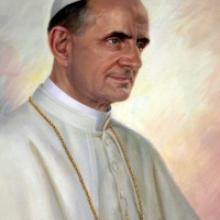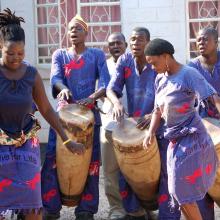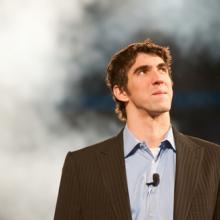Miracles
Thirty years after the release of the Steven Spielberg film that brought T. Rex to the silver screen and turned velociraptor into a global superstar, I sat in the theater watching Jurassic Park again. But this time, it wasn’t the giant dinosaurs that captivated me. It was a small, intimate conversation between Hammond and Sattler.
The Rev. James Martin is a Jesuit priest and popular author who wrote about his lifelong fascination with the saints and the many aspects of sainthood in the Catholic tradition in the best-selling book My Life With the Saints.
Loyola Press is issuing a 10th anniversary edition of Martin’s memoir in September, which also coincides with the Sept. 4 canonization of Mother Teresa of Calcutta, who even during her lifetime – she died in 1997 – was regarded by millions as a “living saint” for her work with the destitute in India and around the world.

Image via Fredrick Nzwili/RNS
Led by charismatic preachers and self-proclaimed prophets, African churches are swelling with promises of miracle healings, signs, and wonders. But in recent months, governments across the continent are trying to rein in these churches.
To Roman Catholic officialdom, it’s unclear whether the Virgin Mary appeared to Ivan Dragicevic and five others 34 years ago in a Bosnian village.
What is clear is that Dragicevic won’t be appearing Wednesday to speak in St. Charles, as some had hoped.
Earlier this month, Archbishop Robert Carlson addressed a memo to priests and deacons in the archdiocese:
“I have received a request from the Congregation for the Doctrine of the Faith to remind everyone that they are not to participate in events that promote the so-called visionaries of Medjugorje and in particular Mr. Ivan Dragicevic.”
Prior to the March 3 memo, Dragicevic had been scheduled to speak in St. Charles’ Lindenwood University, about 25 miles from St. Louis.
Dragicevic is one of six who claim the Virgin Mary appeared and spoke to him in 1981 in Medjugorje, a town situated in the Herzegovina region of Bosnia.
In 2010, the book, The Boy Who Came Back From Heaven, was released. At the time, I believe I gave this news about 0.3 percent of my attention, and 0.1 percent was spent lamenting terrible theology prevalent in the popular Christian book market.
I don’t believe we die and are snatched up to heaven, but that is subject for another post — or better yet, go read N.T. Wright’s Surprised by Hope. Another 0.1 percent of my energies went toward flinching and cringing at the way this boy was IMO being exploited for book sales. In hindsight, I should have spent more time praying for him and his mother, whose cries for truth has been silenced by the powerful machine of the publishing industry. The last 0.1 percent was energy exerted to shaking my head at the allure of sensationalism — enough to shift millions of books and a movie deal.
It came as no surprise when last week The Boy Who Came Back From Heaven retracted his story.
New Jersey is often dismissed as a cultural wasteland of traffic jams and suburban sprawl, mobster graveyards and lost dreams — source material for native son rockers like Bruce Springsteen and Jon Bon Jovi.
But soon the state may also be known as home of the latest American saint, a Bayonne-born nun who is to be beatified in Newark next month.
The beatification of Sister Miriam Teresa Demjanovich, who died in 1927 at the age of 26, puts her one step away from formal canonization.
If Demjanovich does make the final hurdle, she would become just the second person born in the U.S. ever to be named a saint, and it would give New Jersey something to brag about — albeit humbly, no doubt.
A QUESTION ASKED of me 100 times in the last 10 years: Why do you stay in the Catholic Church? How can you stay in a church where thousands of children were raped around the world? Where men in power covered their ears to the screams of children and moved the rapists around from parish to parish so that smiling welcoming parents presented their awed shy children to the rapists like fresh meat? Where women have been marginalized and sidelined for centuries and their incredible creativity diluted and wasted and left to rot? Where power and greed and cowardice so often trumped the very humility and mercy and defiant belief in the primacy of love on which the church was founded and for which it claims to stand today?
Because, I said haltingly, in the beginning, when I was unsure of my honest answer in the face of such rapacious crime and breathtaking lies, because, because ... because how could I quit now? What sort of rat leaves the ship when it is foundering and your fellow passengers need help? Why would I quit now, of all the times to quit? How could I leave the ship in the hands of the men who nearly sank her? How could I abandon the brave honest mothers and priests and nuns and teachers and bishops and dads and monks and children who are the church, who compose the church, who sing the deepest holiest song of the real church?
Because, I said more and more energetically as the years went by, because there are men like my archbishop in my church, men who stood up to lies and crime and accepted the lash of public insult without a word, though the sins were not theirs.
It’s almost a year since Pope Francis was chosen as Benedict XVI’s successor. The Argentinian-born pontiff has quickly achieved global fame for his numerous statements indicating that significant changes may be coming to the Roman Catholic Church.
One possible change emerged last month when London’s Sunday Times reported that Francis wants to make public the Vatican’s archives of Pius XII’s pontificate. Eugenio Pacelli became pope in 1939 and served as pontiff during the period of World War II and the Holocaust until his death in 1958.
According to the British newspaper, Francis wants to release the Pius XII papers for study before determining whether to consider his controversial predecessor for sainthood. Francis has already “fast-tracked” the path to sainthood for John XXIII and John Paul II, but not Pius XII.
Vatican theologians have given their approval to a miracle attributed to the intercession of Pope Paul VI, moving him a step closer to sainthood.
The team of medical professionals and doctors that advise the Vatican’s Congregation for the Causes of Saints already had approved the same miracle in December. Now that a panel of theologians has signed off, the miracle only requires a review by Pope Francis to be considered official.
When that happens, Paul will be beatified — the final step before sainthood. A second miracle is typically required for canonization.
EVERY SO often an extraordinary book appears with potential to bring change—or at least advance justice by mitigating nationalism or prejudice. Rabbi Michael Lerner’s Embracing Israel/Palestine: A Strategy to Heal and Transform the Middle East is such a book. The appeal is clear: Be both pro-Palestinian and pro-Israeli and pray for the best for each.
The book is a gut-wrencher as it describes the results of cyclical violence and reaction that fuels descent into paralyzing trauma and anger for both Arabs and Israelis.
Lerner, an advocate for Middle East justice and founder of Tikkun magazine, speaks truth about the human-made tragedy of the Israeli/Palestinian conflict. His transformative counsel about what people and nations can do to participate positively is desperately needed. Social justice advocates have been offered a candid and honest reprise of the tragic thinking and actions of oppressed people who should have known better than to visit the same on “the other.”
Lerner’s way toward peace is grounded in many years of living in and traveling to Israel/Palestine, loving the two protagonists equally, and constantly exploring his and others’ souls. In spite of the victimizing and traumatizing of both Jews and Arabs, he remains hopeful. Embracing makes for a compelling and even inspiring read. I devoured most of it in two sittings, captivated by Lerner’s vision.
A PROFOUND SENSE of expectation launches a new year. As the season of Advent commences the Christian year, just weeks before the turn of the calendar year, familiar biblical stories invite us to begin again by glimpsing the coming reign of God. Weekly worshippers and annual attendees gather for the season premiere of the greatest story ever told. A promise. A vision. A hope. Great expectation.
The ancient prophet, psalm, gospel, and epistle together extend to the contemporary preacher words of unflinching hope that emerge fresh from the rubble of turmoil, trial, and tribulation of every God-seeking generation. Today’s words of hope must also descend like the savory aroma of a holiday meal, promising solace to the harmed, heartbroken, and hindered.
Familiarity with the Advent and Christmas narratives may leave us unaware of the radical expectation and potential impact that reciting these events can bring. These readings offer an arresting narrative of divine presence inaugurating an unprecedented commonwealth from among the divided nation. The vision makes no sense if it does not offer an alternative to the existing promises of “life, liberty, and the pursuit of happiness.” The narrative challenges us to understand that our celebration of the birth of Jesus is not shiny lights or a musical presentation. It anticipates the arrival of goodness signaling an end to corruption and gloom. This global holiday extends the drama narrated in Christian scripture as each generation must wrestle again with the contemporary relevance of the birth of Jesus.
IN MY MEMORY from nearly 50 years ago, the great pitcher Sandy Koufax is going against my Phillies in the old Connie Mack Stadium in Philadelphia. The records show that such a game occurred on June 4, 1964, the right year for my memory, so it is possibly correct. But I cannot prove I was there that day, nor can anyone prove I wasn’t. For me, it has entered the realm of myth—I may not actually have been there, but in my memory I believe I was. In a similar manner in religious experience, historical events originally recorded as perhaps inexact memories come to be believed as literal truths.
In Baseball as a Road to God, John Sexton uses the categories of the study of religion to explore the meaning of baseball. Sexton, president of New York University, has taught a popular seminar on this topic for more than 10 years, and in this book collects the essence of those classes.
For a baseball fan, the well-told stories of historic players, games, and seasons are by themselves worth reading and will evoke many memories. But rather than a random collection of stories, Sexton groups them in topics—sacred place and time, faith and doubt, conversion and miracles, blessings and curses, saints and sinners—illustrating each with fitting examples. Underlying it all, he proposes, are two words and concepts that link baseball and religion. Both illustrate the significance of the ineffable, “that which we know through experience rather than through study, that which ultimately is indescribable in words yet is palpable and real.” And both have moments of hierophany—a term devised by religious historian Mircea Eliade to signify “a moment of spiritual epiphany and connection to a transcendent plane,” a “manifestation of the sacred in ordinary life.”
When the Vatican announced this month that Pope Francis would formally elevate Popes John Paul II and John XXIII to sainthood, two things stood out.
For John Paul, it was the record speed that he reached sainthood, just eight years after his death. The only other saint to be canonized so quickly in modern times was Opus Dei founder Josemaria Escriva, whose sainthood bid took 27 years.
But for John XXIII, Francis decided to waive the church law that requires a second miracle in order to be named a saint. Asked how John XXIII could be named a saint without the required second miracle, the Vatican’s chief spokesman said “no one doubts his virtues.”
Pope Francis declared on Friday that Popes John Paul II and John XXIII will be made saints, elevating the two most decisive popes of the 20th century to the pantheon of Catholic life and worship.
In a sign of the worldwide devotion for John XXIII, known as “Good Pope John,” Francis waived the requirement for a second miracle credited to John XXIII’s intercession, with the Vatican’s spokesman saying, “no one doubts his virtues.”
Francis signed off on a decree recognizing the second miracle attributed to the Polish-born John Paul II, who reigned from 1978 to 2005 , and is credited with globalizing the papacy and playing a key role in the downfall of the communist regimes of Eastern Europe.
IN THE EARLY weeks of the Eastertide lectionary, there appears a series of texts from the third and fourth chapters of Acts ... Peter and John, on their way to temple prayers, heal a man begging at the beautiful gate. His joy begets a sermon from Peter on the resurrection, at the close of which the disciples are arrested and spend the night in jail. The next day in court they again testify boldly, refuse to comply with the court's order, and are released after calculated threats from the authorities. Their release prompts prayers of thanksgiving in the community.
As people of faith, it is not uncommon to pray for miracles when faced with overwhelming obstacles. For many of us, AIDS has been one of those mind-boggling, heart-wrenching causes that has wreaked havoc on the world and been the subject of many prayers.
Since the early days of the disease, the focus has been on a cure. Researchers worked tirelessly for it and the faithful asked God to provide it. But the cure has never come.
And yet, as we mark another AIDS Day this Saturday, Dec. 1, there is evidence of the miraculous.
After 24 years of commemorating this day with grim statistics and little hope, there is finally good news.
Millions of people are receiving treatment. Many fewer people are dying.
The new infection rate has dropped by 50 percent or more in 25 countries since 2001. With access to treatment, being HIV-positive is now considered a chronic disease, not a fatal one.
Michael Phelps was accomplishing things no one in recorded history has ever done before. I can’t explain or really comprehend how he can do it. And although he did them, I attribute his physiology and gifts to God. So is what he does in the Olympics a miracle?
It almost seems that we worship him as if they were miraculous acts. We literally put him up on a pedestal and adore him, much like how people adored Jesus. And just like with Jesus, these amazing feats, whether or not they are literally miraculous acts, are simply not enough. The fall will inevitably come.
If they were, Jesus wouldn’t have been abandoned at his most vulnerable moment. Some will argue that he saved the biggest and best for last, raising from the dead, which finally put all of his doubters in their place. Really? Then why are our numbers, at least in the Western World, in such precipitous decline?
“The spirit that enables one person to overleap the boundary of the body in knowledge and love and to incorporate the other in the self is matched by the same spirit in the other.”
~ Luke Timothy Johnson, Living Jesus: Learning the Heart of the Gospel
“He said to her, ‘Daughter, your faith has made you well; go in peace, and be healed of your disease.’”
~ Mark 5:34
After several days of renewed public debate about health care, we hear this weekend the familiar healing stories from Mark chapter 5. By Sunday we will know the U.S. Supreme Court’s decision regarding challenges to the Affordable Care Act. So politically charged is this discussion, so designed is it to distort, divide, undermine, and confuse, it’s easy to forget that the issue, at its core, is a simple one: how ought a humane society tend to its suffering ones and aim for the well-being of all?
We will also hear this passage on a day when many will be anticipating the Fourth of July, and perhaps expecting their Sunday worship to kickstart the holiday’s celebration. In hearing the text from Mark, such worshipers might well wonder: What does Jesus’ encounters with a desperate, suffering woman and a young girl believed to be dead have to do with America’s love of freedom and fireworks?
Beyond the typical objections that the Harry Potter books will turn children into Satan-worshipers and encourage them to disrespect authority, one mom complained that she found it inappropriate that at Hogwarts food magically appears on the table at mealtime. Her argument was that she wants her children to have a good work ethic and not to believe that anything in life is free. She wanted her girls to know that preparing meals is hard work and so would therefore be sheltering them from this absurd depiction of people getting something for nothing.
I think at the time I had to restrain myself from asking if she also banned her kids from hearing the story of the feeding on the 5,000 in Sunday school, but it was hard not to think about her objection a few months later as I read The Goblet of Fire and its subplot about house elves. As it revealed, food does not magically appear on the tables at Hogwarts, it is prepared by hardworking elves who in the wizarding world are generally kept as slaves.
"This is the season to celebrate miracles," President Obama said. "This is the season to celebrate the story of how, more than two thousand years ago, a child was born to two faithful travelers who could find rest only in a stable, among cattle and sheep. He was no ordinary child. He was the manifestation of God’s love. And every year we celebrate His birth because the story of Jesus Christ changed the world. For me, and for millions of Americans, His story has filled our hearts and inspired our lives. It moves us to love one another; to help and serve those less fortunate; to forgive; to draw close to our families; to be grateful for all that has been given to us; to keep faith; and to hold on to an enduring hope in humanity."
















